Bog Invertebrates (Protozoans, Platyhelminthes, Rotifers, Gastrotrichs, Nematodes, Tartigrades, Annelids, Arthropods, Desmids And Miscellaneous Groups) Living Within The Sphagnum Mat At The Hidden Valley Nature Center Bog in Jefferson Maine
Robert Zottoli
Professor Emeritus
Fitchburg University
Table of Contents (Introduction)
A. Purpose
B. Location
C. General Information
D. Materials and Methods
E. Sphagnum Mosses
i. General Information
ii. Descriptions of Species Identified in this Study
____________________________________________________________________
A. Purpose:
The web site was created to:
1. Bring attention to the generally high diversity of the microscopic flora and fauna living in the Sphagnum Mat at the Hidden Valley Nature Center in Jefferson Maine.
2. Provide written descriptions, photographs, and videos of the dominant organisms here so that anyone without a microscope can learn more about this amazing hidden world.
B. Location:
Hidden Valley Nature Center is located at 131 Egypt Street in Jefferson Maine. Information about the center can be accessed at http://hvnc.org and the Kettlehole Bog at http://hvnc.org/kettlehole-bog/ .The bog can be viewed on Google Maps by first installing the free program and then typing in the Town, State and Address. The Bog appears as a small body of water above and to the right of the Hidden Valley sign.
C. General Information:
One of the high points (at least I thought so) of my ecology course for biology majors at Fitchburg University was a field trip to a local Kettlehole Bog (Mud Pond in Ashburnham Massachusetts). It involved an arduous trek to the outer edge of the floating sphagnum mat. We discussed the distribution of the major bog plants and how each species was adapted to live in this hostile environment. Recently I photographed many of the common bog plants at several locations along the Maine coast throughout several growing seasons. Many of the photographs along with information on anatomy and adaptive features can be accessed on Wordpress at http://rzottoli.wordpress.com/introduction and at http://hvnc.org/kettlehole-bog/.
In 2013 I decided to identify common microorganisms living in the Sphagnum mat to genus when possible. Five stations were established from the landward edge of the Hidden Valley Nature Center Bog to its outer edge. Samples were collected at these sites from April to September. Organisms were identified using appropriate keys. Videos showing anatomical and behavioral features of each genus are included along with brief descriptions.
D.Materials and Methods:
Digital images were taken at different times throughout the seasons by Robert Zottoli. Most of the photographs were snapped with Nikon D7000 or D800 SLR digital cameras, both equipped with a 85 mm AF Micro Nikkor 1:3.5 D lens. Videos were filmed through a trinocular compound (Nikon Eclipse E200 ) microscope with a C-Mount Digital ToupTek Camera (USB3 CMOS 10000K PA) equipped with a 10 Mega pixel chip at about 25 frames per second. The videos were posted on VIMEO and their codes are embedded in the manuscript so that they can be accessed directly. Organisms were identified to Genus whenever possible.
The following references were used to identify bog invertebrates:
Patterson, D.J., 1996. Free-Living Freshwater Protozoa. A Colour Guide. John Wiley & Sons, New York. 223 pp.
Pennak, R.W., 1989. Fresh-Water Invertebrates of the United States. Protozoa to Mollusca. Third Edition. John Wiley & Sons, New York. 628 pp.
Thorp, J.H. and A.P. Covich, Eds., 2010. Ecology and Classification of North American Freshwater Invertebrates. Third Edition. Elsevier Press, New York. 1021 pp.
The website was constructed using Dream Weaver CS6 and WordPress (www.wordpress.com). Digital images and movies provided on this website may be reproduced for non-commercial, personal, educational or scientific purposes only. Copying or redistribution in any way for personal or corporate gain is not allowed without written permission from Robert Zottoli (rzottoli@roadrunner.com). Use the following format to find pictures and give credit to photographer Robert Zottoli: http://zottoli.wordpress.com/
Samples of Sphagnum Moss, each about 9x9x9 cm, were collected at 5 locations (Stations), in wet areas, beginning at the landward edge of the bog in April, May, July, August and September (2013). The samples were immediately placed in plastic bags for transport to my home. The contents of each bag were transferred to separate black plastic trays (Approximately 14x24x4 cm) filled with about 200 cc of water. Initially the contents of each tray were examined under a dissecting microscope for macroscopic organisms. Then the moss was stirred vigorously , allowed to settle and then sediment was collected with an eyedropper at six randomly selected locations in the tray. Two drops of each sample were placed on separate glass slides and examined at 40X under a compound microscope (Nikon Eclipse E200) for large organisms. Then a cover glass was placed over the exposed sample and examined under 100X, 400X and occasionally 1000X The monthly samples in 2013 (April 16th, May 28, July 22, August 28 and September 14) were re-examined each week for three weeks after the collection date.
Station 1 as mentioned above was located at the landward edge of the bog. The most abundant species of Sphagnum collected at this site was Sphagnum cuspidatum followed by Sphagnum palustre. All species of Sphagnum are described below.
Station 2, situated at about the middle of the Black Spruce Zone, had the same species composition as Station 1.
Station 3 was located just beyond the end of the Black Spruce Zone. Sphagnum capillifolium sub-species rubellum was the dominant form here followed by Sphagnum palustre.
Station 4 was located on the right hand side near the end of the bog walkway. Sphagnum capillifolium sub sp. rubellum was the dominant form; Sphagnum palustre was present but not as abundant as at Station 3.
Station 5 was located a short distance from the front of the HVNC walkway. Both Sphagnum capillifolium and Sphagnum capillifolium Subsp. rubellum were found here in approximately equal numbers.
E. Sphagnum Mosses
Sphagnum Moss is the dominant mat forming organism in the HVNC Kettle Hole Bog . Here the plants form thick green or red, spongy mats that literally float on water. The moss is alive and green towards the surface and dead (Reddish Brown) underneath as shown below. The basal non-living moss accumulates over time and may extend several feet below the mat surface. Over time as dead moss accumulates and is pressed downward, it forms peat

Certain chemicals such as Tannin, p-hydroxyl phenols and the polysaccharide Chitosan are released from the dead tissue, slowing bacterial growth. In addition, water here tends to be anaerobic, further inhibiting bacterial and fungal growth. On the other hand, water surrounding living moss is well oxygenated through active photosynthesis and constant contact with the atmosphere, allowing aerobic organisms to colonize and thrive in this limited environment. Water is absorbed and transferred to large empty cells in the Moss, providing moisture for the Sphagnum plant as well as other plants and invertebrates. Sphagnum is also hydrated by water that percolates into the floating mat from below.
The top (Capitulum) of the Sphagnum plant in most species lies just above the water surface. It consists of a number of leaf-bearing branches that in some species resembles a mop head. The Capitulum is attached to a stem that extends downward into the bog. The lower part of the stem dies and eventually becomes peat. The stem has leafy branches that occur in groups of 2-6 along its length. The stem also gives rise to single leaves along its length. As the bottom of the stem dies, new stems and branches are added from the Capitulum (Top Down Growth). Sphagnum has two distinct generations (Sporophyte and Gametophyte). The gametophyte generation produces egg and sperm. Sperm from a male gametophyte fertilizes an egg produced by a female gametophyte. In Sphagnum the Sporophyte , attached to the top of the female gametophyte, produces spores that disperse and grow into gametophytes. Sphagnum moss can also grow asexually.
Capitulum
Sphagnum plants grow side by side and the branches and leaves of one plant come in contact with those of another plant forming a thick mat creating a three-dimensional living space with an enormous amount of surface area available for microscopic organisms as a platform to feed, reproduce, and hide from predators.
ii. Description of Sphagnum species identified in this study
Specimens were identified using the key in McKnight, K.B. et al., 2013. Common Mosses of the Northeast and Appalachians. Princeton Field Guides. Princeton University Press, New Jersey. 391 pp.
Sphagnum capillifolium Subspecies rubellum
The apical head of this subspecies is dark red and the stem, branches and leaves are for the most part red., otherwise they have the same basic characteristics as S. capillifolium described below
Sphagnum capillifolium (Domed Peatmoss)
Most specimens, about 9 cm long, were colored with a mixture of red and green, however some were completely green. The head (Capitulum) is somewhat domed. Groups of up to 5 branches arise from single points along the stem. The lance-shaped branch leaves are about 1 mm long and are not arranged in rows. The edges of branch leaves are not strongly curved inward and the leaf tip is relatively long and narrows gradually towards the tip. There is no hood at the leaf tip.
Branch Leaf
Stem Leaf
Sphagnum cuspidatum (Long Leaf Peat Moss)
This species , found in wet, low-lying bog areas, is about 10 cm long. The apical part (Capitulum) of the plant is dark green and somewhat flat (Not Dome-shaped). Groups of up to 5 stringy branches arise from single points along the stem. The lance-shaped branch leaves are about 3 mm long, and have pointed tips that are slightly turned to one side. The stem leaves, about 1 mm long, are triangular and have pointed tips.
Stem Leaf
Sphagnum palustre (Blunt-leaved Peat Moss)
The blunt-leaved peat moss is about 10 cm long and has a greenish apical head (Capitulum). The branches extending from the Capitulum are relatively wide and taper almost to a point anteriorly. Egg-shaped branch leaves , about 2mm long, have in rolled margins that form a blunt, hooded tip . The stem leaves, about 2 mm long, are tongue-shaped.

![moss-sphagnum-sidney-bog-april-3-2010-17[1]](https://boginvertebrates.wordpress.com/wp-content/uploads/2014/02/moss-sphagnum-sidney-bog-april-3-2010-1711.jpg?w=1000)
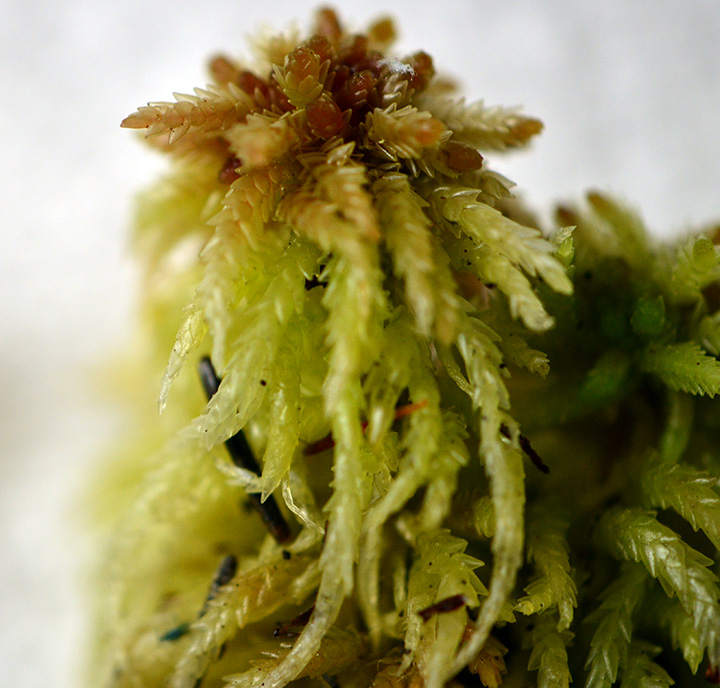

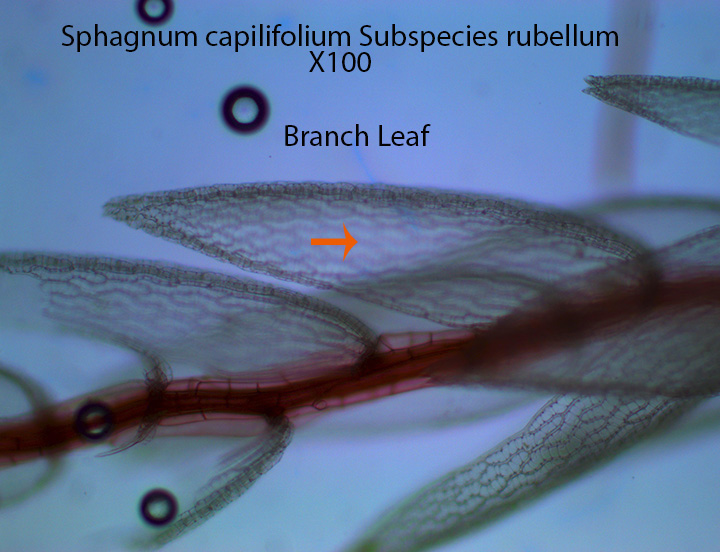
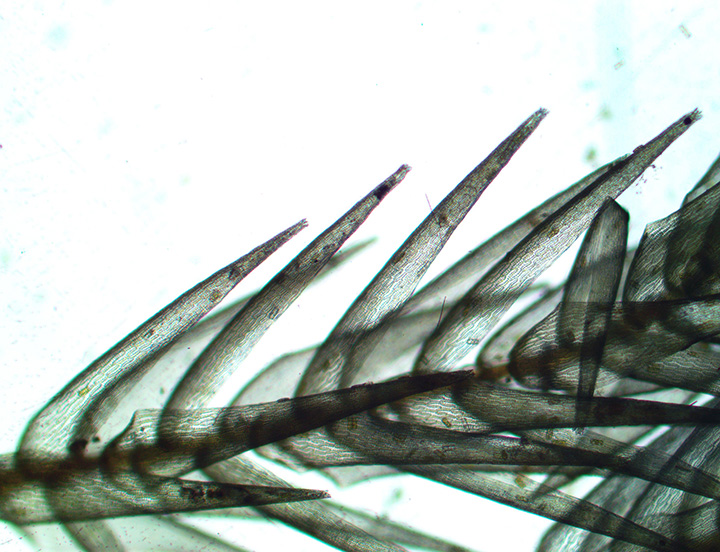

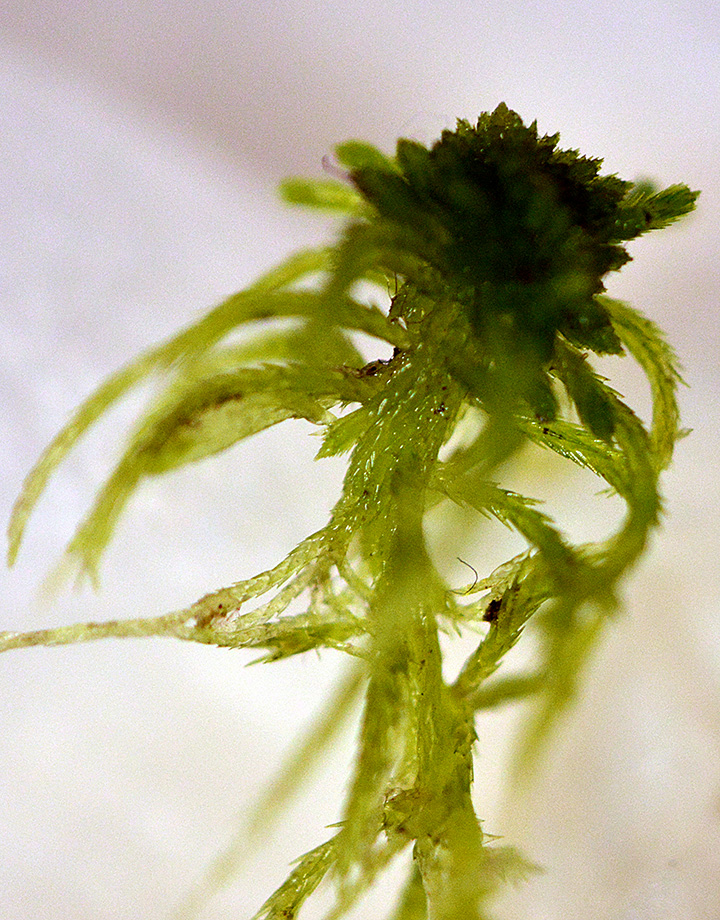
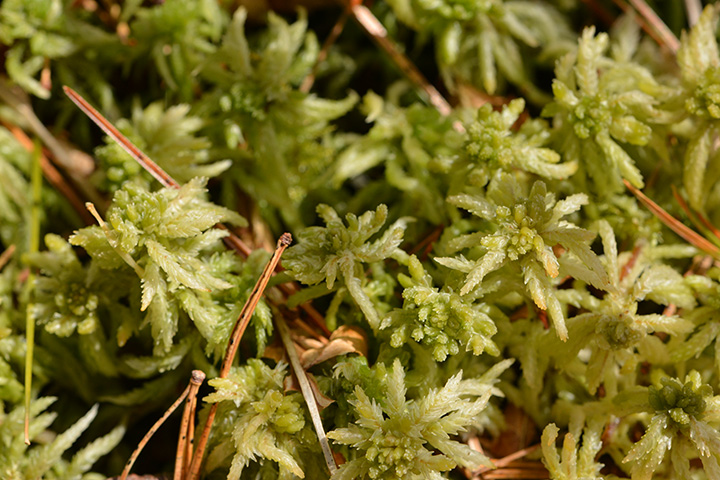
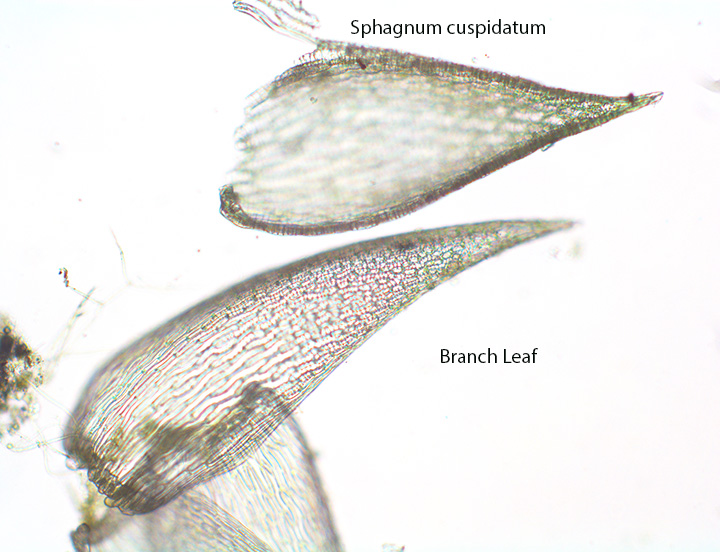
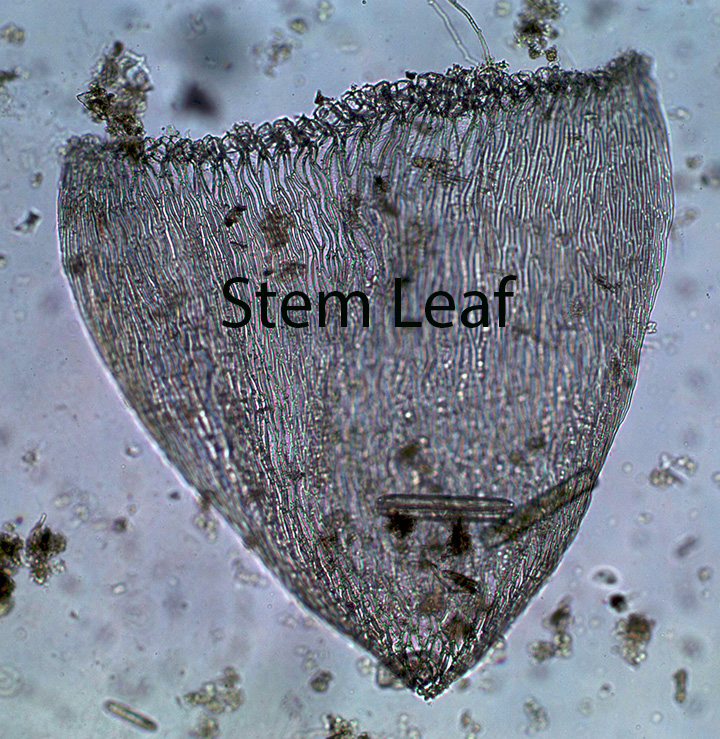

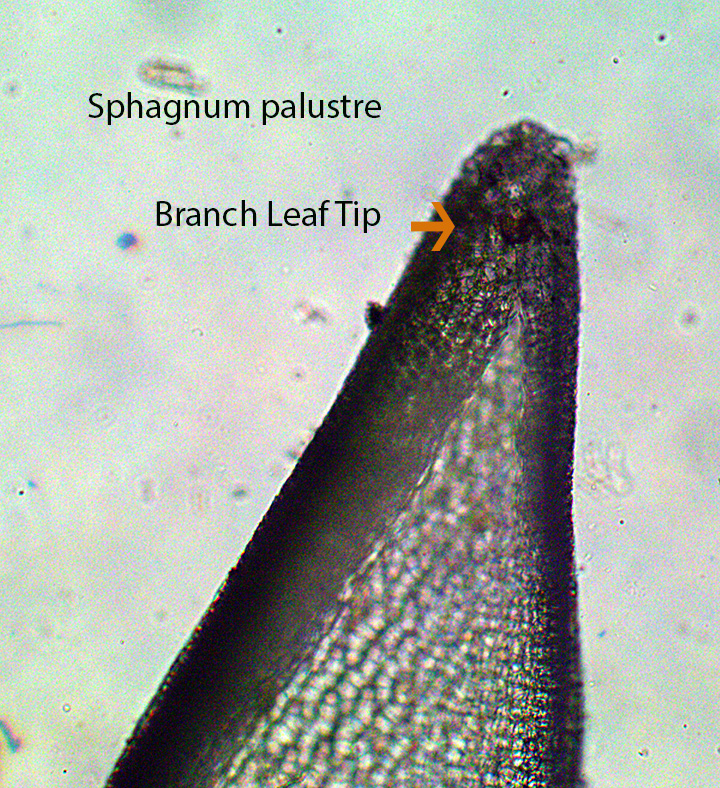

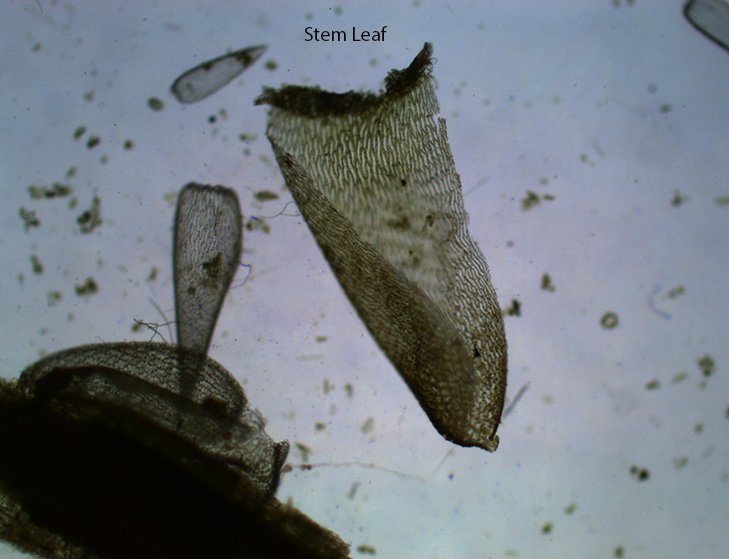
Leave a comment